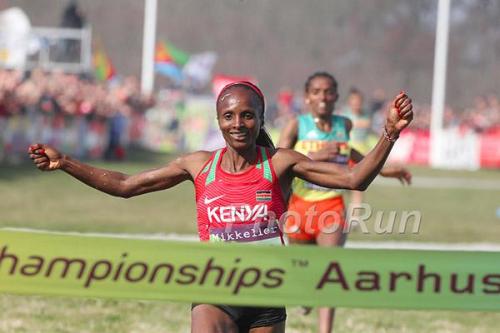 Hellen Obiri takes the 2019 WXC in Aarhus, photo by PhotoRun.net
Hellen Obiri takes the 2019 WXC in Aarhus, photo by PhotoRun.net
Runblogrun asked Justin Lagat to provide a reason for the less than stellar performances in Aarhus, Denmark. Justin provided five reasons.
I know of one former senior police officer who would tell anyone to go away and come back with just one reason whenever one gave him more than two reasons as to why something may have happened.
So, here I am, trying to find the one reason as to what may have caused the dismal performance by Kenyan athletes in Aarhus, and below are the various possible reasons.
1. The national trials were done on high altitude.
For the first time in Kenya, the national cross country championships were done outside Nairobi and there were some major upsets. Some of the main contenders including Agnes Tirop and Edward Zakayo, among others, gave in to the high altitude and the harsh weather conditions in Eldoret and could not make the team.
Perhaps, if the national trials had been done in Nairobi as usual, or on a lower altitude, we would have sent a formidable team to the world championships like we have always been doing.
It might be time that all the national trials in Kenya are done on altitudes that are closer to those on the competition venues.
2. The national training camp was held in Gigari Embu, as usual, despite the anticipated tougher course.
Some months before the world championships could happen, the course had already been revealed and it appears like the Kenyan runners did not customize their training to suit the topography of the Aarhus course.
Ethiopian runners looked stronger on the hilly sections of the course compared to the Kenyans and one could tell that they did train on surfaces more similar to the Aarhus course.
3. The race itself was not a speed test, but rather a test of the mental toughness of the runners.
No one can question the fact that Kenyan runners are the best long distance runners in the world, but the Aarhus course was not testing exactly that. It was more of a mental toughness game and whoever wanted to win it the most. Uganda’s Joshua Cheptegei had a strong desire to win, owing to the humiliation of being beaten on his home ground in Kampala. He even did a study of the course early and adjusted his training to suit it.
4. The changing of training bases for athletes after making it to the national team.
If one makes it to the national team in Kenya, it definitely means that wherever they were training and the coaches they have been training with were working just fine. It is hard to understand why Kenyan runners would suddenly need to change their successful training places and coaches after making the national team.
Hellen Obiri did not change her training base after winning the national title and she emerged victorious in Aarhus, contrary to Amos Kirui who won the men’s national title, changed his training base to Embu and faded in Aarhus.
5. The 10,000m and 5,000m races are slowly becoming extinct.
Many of the past world cross country champions, like Vivian Cheruiyot, Kenenisa Bekele and Paul Tergat used to dominate the 5,000m and 10,000m track races as well.
With less market for the long distance track events, many great Kenyan talents are quickly shifting to the longer distances on the roads. Great talents like Brigid Kosgei who is one of the favorites to win the London Marathon this month, Abraham Kiptum who recently set a new world record for the half marathon and Ruth Chepngetich are among the talents who perhaps might have shined in the cross country and track races.
Author

Since 2013, Justin Lagat has written for RunBlogRun. His weekly column is called A view from Kenya. Justin writes about the world of Kenyan athletics on a weekly basis and during championships, provides us additional insights into the sport.
View all posts




















